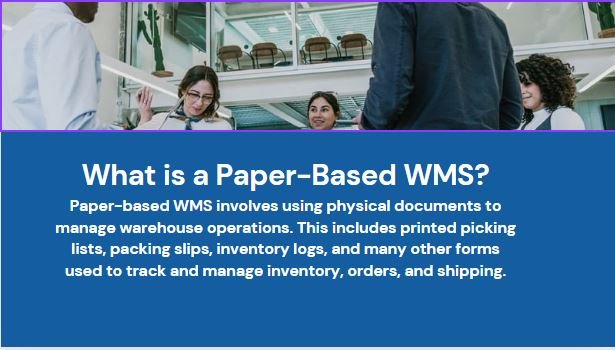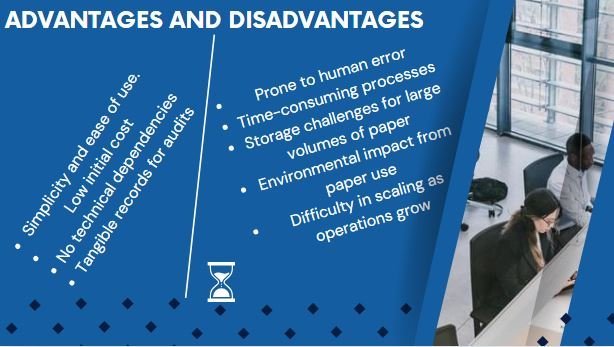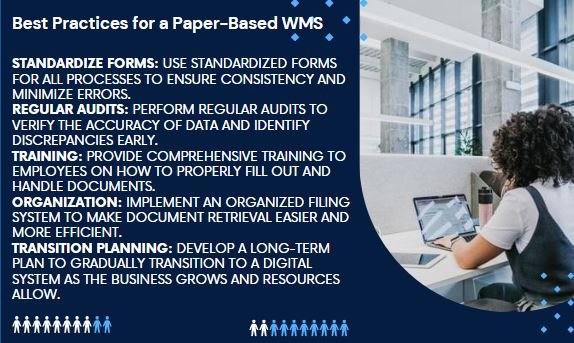- Introduction
- What is a Paper-Based WMS?
- The Benefits of a Paper-Based WMS
- Disadvantages of Paper-Based WMS
- Real-World Applications and Case Studies
- Case Study: Traditional Manufacturing Company
- Best Practices for a Paper-Based WMS
- Conclusion
- Frequently Asked Questions
- What is a paper-based warehouse management system (WMS)?
- Why would a warehouse choose a paper-based WMS instead of a digital system?
- Advantages and Disadvantages Paper-Based WMS
- What are the main advantages of a paper-based WMS?
- What are the disadvantages of using a paper-based WMS?
- How can a warehouse reduce errors when using a paper-based WMS?
- What types of warehouses benefit the most from a paper-based WMS?
- Inventory Handling
- How does a paper-based WMS handle inventory management?
- Can a paper-based WMS be integrated with a digital system?
- Impacts on Environment
- What are the environmental impacts of using a paper-based WMS?
- How can warehouses transition from paper-based WMS to digital systems?
- Are there specific industries where paper based WMS is still preferred?
- Best Practices
- What are some best practices for managing a paper based WMS?
- Can a paper based WMS support scalability as a warehouse grows?
- How does a paper based WMS handle order processing?
- What steps can be taken to ensure data security in a paper based WMS?

Introduction
Warehouse management systems (WMS) are crucial in ensuring efficient operations, accurate inventory management, and seamless workflow within the warehouse. While modern WMS solutions often involve sophisticated software and digital tools, many warehouses still rely on paper-based systems. This traditional approach has its advantages and challenges. In this blog, we will explore the role of paper-based WMS in warehousing, examining their benefits, drawbacks, and scenarios where they may still be relevant.
What is a Paper-Based WMS?
Paper-based WMS involves using physical documents to manage warehouse operations. This includes printed picking lists, packing slips, inventory logs, and many other forms used to track and manage inventory, orders, and shipping.
The Benefits of a Paper-Based WMS
1. Simplicity and Accessibility Paper-Based WMS
Paper-based systems are straightforward and easy to understand. Employees can quickly learn and adopt the system without the need for extensive training. This makes it accessible to a wide range of employees, including those who are not tech-savvy.
2. Low initial costs
Implementing a paper-based WMS is cost-effective, especially for small to medium-sized warehouses. There is no need for expensive software licenses, digital devices or IT infrastructure, making it a viable option for businesses with limited budgets.
3. No reliance on technology
Paper-based systems do not require electricity, internet connectivity or technical support. This means that warehouse operations can continue without interruption during power cuts or technical failures, providing a level of reliability that digital systems cannot always guarantee.
4. Tangible (Physical) records
Having physical documents can be beneficial in certain scenarios, such as audits or legal disputes. Tangible records may be easier to present and verify than digital data.

Disadvantages of Paper-Based WMS
1. Potential for human error in Paper-Based WMS
Manual data entry is prone to mistakes. Mistaken handwriting, data duplication, and lost documents can cause significant errors in inventory management and order processing, impacting overall efficiency and accuracy.
2. Time-consuming processes
Manually recording and transferring data is a time-consuming process. Employees spend more time filling out forms and updating records, which can slow down warehouse operations and reduce productivity.
3. Limited scalability
As warehouses grow, it becomes difficult to manage large volumes of paper documents. Finding specific records in a huge collection of papers can be cumbersome, leading to delays and inefficiencies.
4. Environmental impact
Paper-based systems contribute to deforestation and generate waste, making them less environmentally friendly than digital solutions. The need for constant paper supplies and storage space also increases operational costs.
Real-World Applications and Case Studies
Small Warehouses and Startups
For small warehouses or startups with limited resources, a paper-based WMS can be a practical initial solution. It allows them to manage inventory and orders without any significant upfront investment. As the business grows, they can gradually transition to a digital system.
Remote or Low-Tech Environments
In remote locations or environments with unreliable internet connectivity, paper-based systems offer a reliable alternative. Warehouses operating in such conditions can maintain their operations without being affected by technical constraints.
Case Study: Traditional Manufacturing Company
A traditional manufacturing company used a paper-based WMS for decades. Although the system had its challenges, it was well understood by employees, many of whom had been with the company for years. Transitioning to a digital system would have required significant training and investment. By optimizing their paper-based processes and implementing best practices, they managed to maintain efficiency and accuracy.

Best Practices for a Paper-Based WMS
Standardize forms: Use standardized forms for all processes to ensure consistency and minimize errors.
Regular audits: Perform regular audits to verify the accuracy of data and identify discrepancies early.
Training: Provide comprehensive training to employees on how to properly fill out and handle documents.
Organization: Implement an organized filing system to make document retrieval easier and more efficient.
Transition planning: Develop a long-term plan to gradually transition to a digital system as the business grows and resources allow.
Conclusion
While digital WMS solutions offer many benefits, paper-based systems still have a place in the world of warehousing. They provide a simple, cost-effective, and reliable way to manage warehouse operations, especially for smaller businesses or those in low-tech environments. However, the limitations of paper-based WMS, such as vulnerability to errors and inefficiencies, highlight the need for careful consideration and optimization of processes.
Ultimately, the choice between paper-based and digital WMS depends on the warehouse’s specific needs, resources, and goals. By understanding the benefits and challenges of paper-based systems, warehouse managers can make informed decisions that best suit their operations.
Frequently Asked Questions
What is a paper-based warehouse management system (WMS)?
A paper-based WMS uses physical documents such as printed forms, logs and reports to manage and track warehouse operations. This includes recording inventory levels, order processing, picking, packing and shipping activities.
Why would a warehouse choose a paper-based WMS instead of a digital system?
Warehouses may choose a paper-based WMS for its simplicity, low initial costs and ease of implementation. It is particularly useful for small to medium-sized warehouses, those with limited budgets or environments with unreliable power or internet connectivity.
Advantages and Disadvantages Paper-Based WMS
What are the main advantages of a paper-based WMS?
Simplicity: Easy to understand and use with minimal training.
Low initial costs: Only requires basic supplies such as paper, pens and clipboards.
No technology dependency: Operates without the need for electricity, internet or IT infrastructure.
Tangible records: Physical documents can be useful for audit and legal purposes.
What are the disadvantages of using a paper-based WMS?
Potential for human error: Manual data entry increases the risk of mistakes.
Inefficiency: Processes are slower than automated systems.
Storage challenges: Managing and storing large amounts of paper can be cumbersome.
Environmental impact: Contributes to deforestation and waste generation.
How can a warehouse reduce errors when using a paper-based WMS?
Standardized forms: Use standardized forms to ensure consistency.
Regular training: Regularly train employees on accurate data entry and document management.
Audits and checks: Implement regular audits to catch and correct errors immediately.
Clear handwriting: Encourage clear and legible handwriting to avoid misinterpretation.
What types of warehouses benefit the most from a paper-based WMS?
Small to medium-sized warehouses: With limited budgets and simple operations.
Remote locations: Where power or internet connectivity is unreliable.
Temporary warehouses: Short-term operations that require quick setup and low costs.
Low-tech environments: Where the workforce may not be tech-savvy.
Inventory Handling
How does a paper-based WMS handle inventory management?
Inventory is tracked using physical logs, count sheets and inventory forms. Employees manually record inventory levels, update stock counts and log any changes. Physical counts and audits are performed regularly to ensure accuracy.
Can a paper-based WMS be integrated with a digital system?
While a fully integrated system is challenging, a hybrid approach can be used. For example, paper forms can be digitized periodically, and critical data can be manually entered into the digital system to maintain some degree of integration.
Impacts on Environment
What are the environmental impacts of using a paper-based WMS?
Paper-based systems contribute to deforestation, generate waste, and have a higher carbon footprint than digital systems. Reducing paper use and implementing recycling programs can help mitigate some of these impacts.
How can warehouses transition from paper-based WMS to digital systems?
Assessment: Evaluate current processes and identify areas where digital systems can add value.
Budget planning: Allocate funds to purchase digital devices, software, and training.
Pilot program: Implement digital solutions in a small part of the warehouse to test effectiveness.
Training: Provide comprehensive training to employees on using the new digital tools.
Gradual rollout: Slowly expand the use of digital systems throughout the warehouse.
Support and maintenance: Provide ongoing support to ensure smooth operations and resolve any issues.
Are there specific industries where paper based WMS is still preferred?
Industries with low-tech environments, such as some agricultural operations, traditional manufacturing, and some small-scale retail operations, may still prefer a paper-based WMS due to its simplicity and cost-effectiveness.
Best Practices
What are some best practices for managing a paper based WMS?
Standardization: Use standardized forms and procedures.
Training: Regularly train employees on accurate data entry and document management.
Organization: Implement an efficient filing and retrieval system.
Auditing: Perform regular audits to ensure data accuracy.
Environmental considerations: Use recycled paper and encourage recycling to reduce environmental impact.
Can a paper based WMS support scalability as a warehouse grows?
While a paper-based WMS can support small to medium-sized operations, it becomes more difficult to manage as a warehouse grows. Transitioning to a digital system or hybrid approach can help support scalability and improve efficiency.
How does a paper based WMS handle order processing?
Order processing in a paper-based WMS involves manually recording order details, picking lists, packing slips, and shipping labels. Employees use these documents to complete orders, and updates are manually recorded to track order status.
What steps can be taken to ensure data security in a paper based WMS?
Secure storage: Store documents in a secure, organized manner to prevent loss or damage.
Access control: Limit access to sensitive documents to only authorized personnel.
Backups: Make copies of important documents to prevent data loss.
Regular audits: Perform regular audits to ensure data integrity and accuracy.
